
Booze, Sailors & Health Menu: 1 2 3 4 5 6 7 8 9 10 11 12 13 14 15 16 17 18 19 Next>>
Booze, Sailors, Pirates and Health In the Golden Age of Piracy, Page 3
Containers for Alcohol, continued
Containers for Alcohol: Drinking
Describing drinking containers used on ships during the golden age of piracy is rather challenging. Most containers are only briefly mentioned without any description of what they might look like. Among the terms used are bottle, glass, calabash, cup, bumper, can, dram and bowl. Glass, cup and bowl seem somewhat vague and without any context it is difficult to say what exactly those mentioned in the sailor's accounts looked like or were made from.
Curiously, certain types of containers are hardly mentioned at all in the sea accounts. The word 'mug' is used to describe a drinking vessel as a gift given
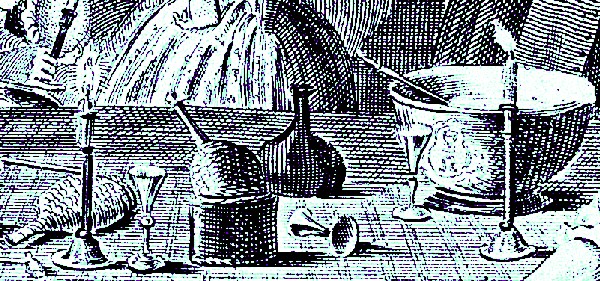
Artist: Thomas Bowles - Early 18th Century Drink Containers, From The Rake Carouses in a Tavern (1735)
to an African duke in William Snelgrave's account1 and to describe the dowry of two orphans captured by pirate Thomas White's crew2. Never is it mentioned being used as a drinking vessel by a sailor.
The word tankard appears in only two accounts. One where one of the forced men taken by Edward Low "was drinking with a Silver Tankard at one of the Ports" which he kept as it "might prove of some Use to him"3. The other is in the list or prices that Captain Jacobs charged while selling supplies to the pirates on Madagascar. The account explains that one barrel of beer was sold for three pieces of eight, while "the Rest retailed by the Tancker at a pc of 8 the Tancker, which held about ⅓ of a Gall[o]n."4
The word costrel or blackjack (a formed leather bottle) is not found in any of the period sailor's accounts.5 It is interesting that so many containers commonly suggested to be used by pirates and sailors do not appear in many of the actual accounts. Of course, this does not mean they were never used, only that they weren't mentioned.
One vessel in this category which does rate a couple mentions is the cann or can. In his dictionary,
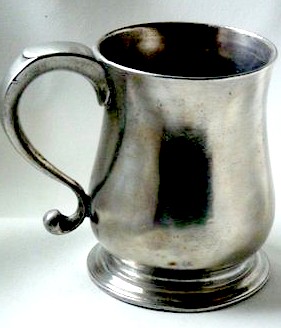
Pewter Cann (18th century)
John Kersey explains that a 'cann' is "a kind of vessel, or Cup to drink out of."6 This is not particularly descriptive or even helpful in understanding what a can looked like. However, an essay on the New York Metropolitan Museum of Art explains that these are "tulip-shaped vessels on a circular foot
"7. Like a tulip, these containers have a distinctive bulbous part at the bottom which tapers up to straight metal sides and a flared mouth. The bulb can be more or less pronounced, and a handle gives them a distinctively mug-like appearance. In keeping with their modern brethren, canns appear
to have been made primarily of metal, particularly silver and pewter, although some are also said
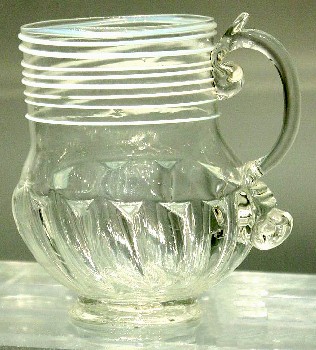
Photo: Valerie McGlinchey - Ale Mug or Glass Cann? (1680-90)
to be made of ceramic and the glass 'mug' seen at left appears to conform to the definition as well.
Mentions of canns are found five times in the period seaman's books8, used as containers for flip9, beer10 and wine11. When pirate captain John Martel is described by a prisoner, he "bid me welcome, and drank to me in a Can of Wine"12 in a mock salute. One of captain John Rackham's men is also noted to have borrowed some sugar from the ship's surgeon whereupon he "made a Can of Phlip [Flip]"13, which involves sticking a red hot poker into the concoction. Naval physician William Cockburn also says that canns were used by sailors to drink flip14, suggesting they were a particularly useful vessel for that drink.
Glasses are mentioned several times. In his 1728 Cyclopedia, Ephraim Chambers defines drinking glasses as "simple Vessels, of common Glass or Crystal, usually in the form of an inverted Cone. Each Glass consists of three Parts, viz. the Calix, or Bowl; the Bottom; and Foot, which are all wrought, or blown separately."15
Photo: Simon Speed
Glasses from the Time of William and Mary's Reign (1689-1702)
He goes on to note that by the time of his writing crystal glasses had fallen out of favor in England due to their brittleness.
Glasses are found directly mentioned four times in the sailors accounts16, three times containing wine17 and once containing brandy18. As can be seen in the first image in this section, small glasses were also typically used when drinking punch, although they are usually not specifically mentioned; rather they seem to have been implied by the presence of the bowl in which the punch was made. Cocktail historian David Wondrich notes that for punch, "the traditional serving is about a sherry glass full, just a couple of ounces"19.
Pirate Bartholomew Roberts' ship seems to have had glasses, as they are mentioned a couple of times. In a letter Roberts wrote to the governor of St. Christopher [today often called St. Kitts] after attacking the fort on the island he explained, "This comes expressly from me to lett you know that had you come off as you ought to a done and drank a Glass of wine with me and my Company I should not harmed the least vessell in your harbour."20 During the court trial of Roberts' men, it was testified that "over a Glass of Wine, the Prisoner [Thomas Sever] lamented his Condition very much"21 in an effort to prove that hev was an unwilling pirate. This (among other things) worked, as Sever was acquitted.
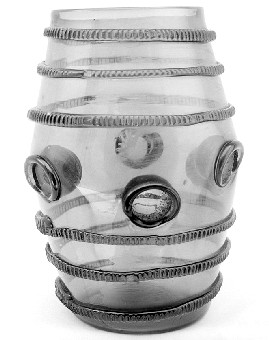
Glass German Bumper (late 17th c.) The 'Hoops'
Were Likely Used for Drinking Games
Another term that turns up in one of the pirate accounts is bumper. However, it is not entirely clear that bumper was a particular type of container. It may instead have been a description of how the container was filled. Alcohol historian David Wondrich explains that a bumper is "any glass filled up to surface tension (hence the "bump") but in practice carried a certain notion of size, so that one might be embarrassed to identify anything less than a gill-sized glass - four ounces- as such."22 Samuel Johnson's dictionary defines bumper as "A cup filled till the liquor swells over the brim"23, which attests to the veracity of Wondrich's comment. However, an image search turns up the photo of the remarkably barrel-like glass jar seen at left being identified by the Metropolitan Museum of Art as a 17th century German bumper glass. The site explains, "The hollows in the side are for a person's fingers to grip when heavy glass is filled with ale or beer."24 These would also be useful for preventing too much spill when the vessel was full to overflowing. An article on collectors of glasses from the New York Times explains, "Collectors today usually refer to a glass with a heavy bottom, a type of bar or tavern glass, as a bumper."25
After his ship Margaret was captured by pirate Edward Low's crew, captain George Roberts describes his life during the days he was held captive. In his book, he explains that the pirates used a bumper glass which was "one of your Hollands Glasses, made in the Form of a Beaker, without a Foot, holding about three Quarters of a Pint"26. While the vessel is not entirely clear from this description, the lack of foot indicates it had no base (like the glasses shown previously did) and the beaker-like description suggests the mouth of the container was flared, unlike our German example. While Roberts notes that the beakers he saw were made of glass, the New York Times article explains that the term beaker, "was used in the 17th century to describe a straight-sided container of silver, pewter, pottery or glass made with a flaring rim."27
Roberts' account contains other points of interest, and so are quoted here in full. "After Supper, a Bowl of Punch, and half a Dozen of Claret, being set on the Table,
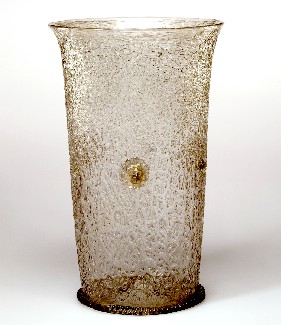
Netherlands Beaker Glass (16th - 17th c.)
Capt. [Jack] Russel took a Bumper, and drank Success to their Undertaking; which went round, I not daring to refuse it."28 If the pirates were following form, these would have been small punch glasses. However, this cannot be told from the narrative.
Roberts goes on to say they kept drinking various toasts ('healths'), and ended up refilling the punch with red wine, which he did not like. He asked to be allowed to drink a bumper of regular claret instead of the punch. "Hereupon Russel said, Damn you, you shall drink in your Turn a full Bumper of that Sort of Liquor that the Company does."29
Another, similar round of toasts took place later while Roberts was trying to negotiate his release from the pirates. He explained that Captain Low "wink'd at me to be silent; and taking a Bumper, drank Success to their Proceedings."30 According to Roberts, Low was in favor of giving him as much as possible when he sailed away with his ship, which Russel opposed. So Roberts was trying to lubricate the company before any decision was made and lull them into giving Roberts more than they intended. This, unfortunately for Roberts, failed to work. Low even apologized for Russel's behavior, but said there was regrettably nothing he could do.
'Cup' is probably the vaguest word used for describing drinking vessels during this period. Ephraim Chambers rather unhelpfully describes a cup as "a Vessel, so call'd, of various forms and uses."31 He points his reader to chalice, which even more unhelpfully points to calix. This turns out to be a drinking vessel used for wine during the mass32, which is probably not what most sailors or pirates were talking about when they mentioned cups. Woodes Rogers mentions that on Valentine's Day his officers drank their "Lady's Health in a Cup of Punch, and to a happy Sight of 'em all"33, which, as we have seen, referred to a small glass. Such glasses would have been appropriate to the celebration as well.
Cups are mentioned four times in the period sailor accounts34, once containing bomboo (a type of punch)35, another time containing punch36, once containing Spanish wine37 and once containing French wine38. It is likely that these references to cups were actually
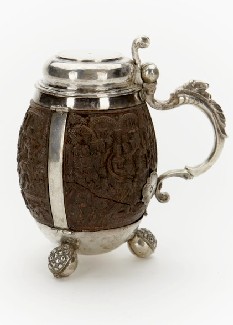
Photo: Erik Lerenstal - 17th c. Coconut Mug
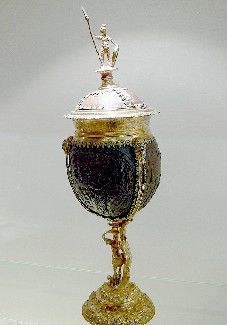
Photo: Wolfgang Sauber - Coconut Chalice 16th c.
references to glasses: punch was typically drunk from small glasses and wine was often drunk from larger ones. If true, this would bring the previous count of glasses up from four to eight.
In his discussion of the Caribbean, physician William Hughes mentions "very handsom drinking Cups" which are made "Of the hard shells [of the coconut] (polished)"39. These cups had been around for over a century at this point and were popular curios in England. (Some of them actually do look like chalices, as seen in the image at right.)
However, it is doubtful that sailors or pirates would have carried such ornate, gilt coconut cups around with them. Some of them may have occasionally just hollowed out a coconut to drink from (needs must), but there is no reference to this or the more stylish coconut vessels in the period sailor's books.
Related to coconut cups are calabashes. A calabash is a type of
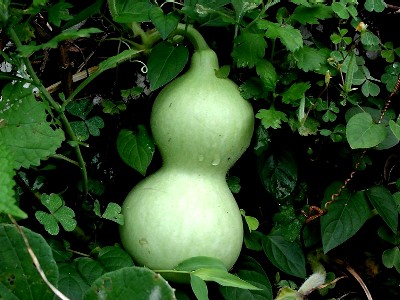
A Calabash Fruit Still on the Vine
vine that produces fruit which can be dried and used as containers. Physician William Hughes explains "the pith and seeds being picked out at a little hole [made in the gourd]: and they being cut in the middle, the Inhabitants [of Jamaica] make necessary furniture for their houses therewith"40. He further explains that this included "dishes of several sorts, carved, graven and plain; the small [types] of them being used to drink their breakfast Chocolate in the morning, and also as necessary vessels to drink such other drinks as the Island affords, as Mobby [fermented potatoes], Rapp, Perino [fermented cassava], Locus-Ale [a mixture of clarified cane juice and rum], Rum &c."41 Hughes finishes his description of the virtues of calabashes by explaining that they "are much used to carry some kinde of strong liquor in (as Rum, or Brandy, and the like) in a mans pocket, to take now and then a dram to support the Spirits in walking far, or travelling the Country; it being very ill and dangerous to drink water at such times, as Experience has taught me, by fainting thereby, in drinking freely thereof when I was hot with walking."42
Two sea account
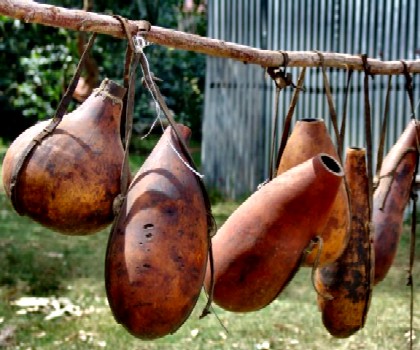
Dried Calabash Gourds For Sale in Kenya
authors mention calabashes as being used to collect the sap of palm trees for making arrack (palm wine)43 and they appear as vessels for carrying water44, milk45 and an alcoholic drink called toke46 (referred to as a 'country liquor' of Madagascar - probably a fermented vegetable drink similar to palm wine or arrack). However, calabashes seem to have been restricted to those living in fairly primitive areas, not being mentioned in use among men living shipboard.
Still, there are some interesting connections between calabashes and sailors. Captain Nathaniel Uring tells of spending Christmas in Central America where, "instead of Punch or Wine, we had Pumpkin Mishlaw; which is made thus, the Pumpkins are cut in small Pieces and boiled; the Inside of which is mashed to a Pulp in the Liquor [liquid] it is boil' d in, and being served out in Calabashes when it is hot"47. He also mentions drinking a plantain and cassava mishlaw from the same vessels. Closer to our subject, Father Jean-Baptiste Labat includes calabashes in his 17th century reenactment of a buccaneer's cochon boucanne (pig barbecue). He explains that those attending were "permitted to drink a shot (un coup) of wine, provided that they drank it in a coui (calabash) without water, for buccaneers never pour water into their wine and drink either pure water or neat liquor."48 Still, all these examples are from people on land in fairly primitive settings, suggesting it would not be commonly found on a golden age of piracy sailing vessel.
Several accounts mention sailors drinking 'drams.' This does not describe any particular container; it refers to the amount they contained. John Kersey's 1708 Dictionary says that a dram (also called a drachm) is "Among Apothecaries, the 8th part of an Ounce, and in Aver-du-pois Weight, the 16th part of an ounce."49 By comparison,
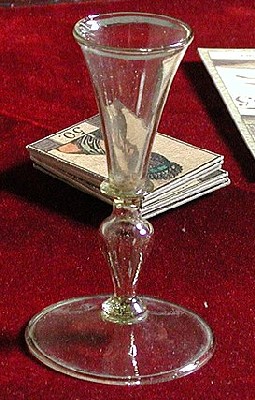
17th/18th c. Italian Cordial Glass, From the MET
a modern shot is about one to one and a half ounces. Edward Vernon's mentions drams in his letter that ordered the change from pure rum to grog (watered down rum with perhaps some lime juice in it) to the ship captains in the West Indies. Vernon explains that "the pernicious custom of the seamen drinking their allowance of rum in drams, and often at once, is attended with many fatal effects to their morals as well as their health"50. We know from the 1731 naval regulations that when spirits were served to them in lieu of beer, they were given a half a pint51, which equates to eight ounces. So a dram could be anything from a sixteenth of an ounce to eight ounces! However, it is highly unlikely that the period dictionary definition of the apothecary measure is the same as the drams drank by pirates and sailors. Many sailors and even pirates had spent time in the navy and had been exposed to the idea of having their drams be eight ounces.
There are small glasses, usually flared, which are sometimes called dram glasses by collectors. The 18th Century Glass website explains that "Dram glasses is a catch all term... for any small glass that doesn't fit into one of the other major categories. It includes small wine glasses, port glasses, and those used for spirits such as whiskey or gin"52. Cordial glasses (such as the one seen at left) would also fit nicely into such a category. However, cordial glasses containers typically contain two to three ounces and port glasses around six. Given that the navy suggests that a dram was about eight ounces and the fact that it cannot be stated with certainty that this was what sailors were drinking their drams from, these seem an unlikely sailor's dram containers. They may have easily used any of the other containers discussed previously.
Drams appear seven times in the sailor's books53, making them one of the more popular ways to refer to containers of booze. Drams are mentioned containing rum54
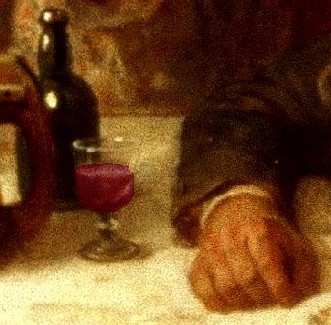
Port Style Glass and Bottle (1866)
and brandy55 as well as generically without reference to the kind of alcohol they contained.56 They are mentioned in naval, merchant and pirate accounts, suggesting that the concept was an important one at sea. During the mock trial that is presented in Charles Johnson's chapter of pirate Thomas Anstis, one of the actors in the trial said, "My Lord, I should have spoke much finer than I do now, but that, as your Lordship knows our Rum is all out, and how should a Man speak good Law that has not drank a Dram."57
Drams are not the only measure mentioned vis-a-vis alcohol containers. Merchant and naval sailor Edward Barlow mentions that the beer in Bergen, Norway was sold "for a penny a quart, which is not dear in that place"58. While in Málaga, Spain, Barlow notes that it cost "but threepence halfpenny and a groat for a quart of good ‘Malego sack’."59 (Sack is typically fortified wine.) Of course, here the term is more distinct from the container than when the sailors mention drams.
Several other terms were in use at this time for alcohol measures. Even though they don't appear in the sailor's accounts, David Wondrich gives such a nice explanation of them that it is worth repeating. "Four ounces are a gill or quartern, four gills or quarterns a pint, two pints a quart, two quarts a pottle and two pottles a gallon."60
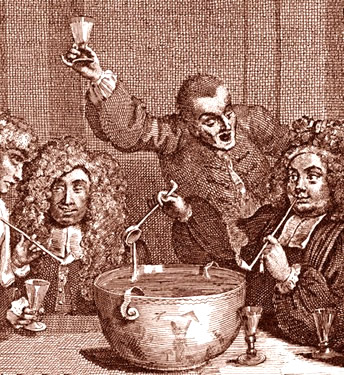
Artist: William Hogarth
Drinking Punch in Glasses from a Bowl. Note the relatively
small glass and
ladle sizes. (1732-3)
The last container to be discussed is the bowl. These contained what is arguably the first internationally successful mixed drink: punch. Punch was made in large bowls and was meant to be drunk by groups of people. Mixologist David Woodrich (who literally wrote the book on punch) notes "that ‘punchbowl’ is first attested to in 1658 and that the drink was reputable enough by 1680 for those bowls to start appearing in silver. Less exalted topers drank from earthenware and even wood."61 He goes on to explain, "Punch bowls came in all sizes, from the covered "sneaker" or' "tiff" that held no more than a cup to the mammoth five-gallon Alderman's special. The default size, however, seems to have held a quart, with double and "thribble" bowls holding the requisite amounts"62. The smaller bowls were passed around the group and sipped from by all present. Punch bowls often came with matching glasses, although after a bowl had been drank, it would not be surprising to lose a few to breakage. While the glasses could potentially be of any size, Wondrich says, "in general, the glasses were not large" and notes that he has a set of two ounce sized punch glasses.63
Punch Bowls are mentioned by sailors during the golden age of piracy twenty-three times64, almost three times as often as the next most frequently mentioned container in
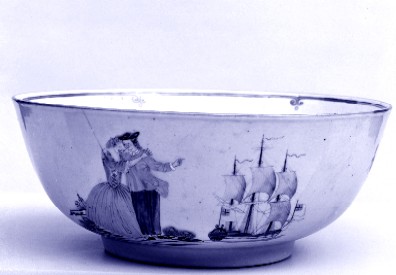
A Sailor-Themed Ceramic Punch Bowl (mid-18th century)
this section. Wondrich says, "The psychopathic [pirate captain] Ned Low kept a two-gallon silver Punch bowl of which he made frequent use (such luxuries are easier to maintain if you don't have to pay for them)."65
Johnson mentions a punch bowl in the account where Low captured Captain Graves' ship and brought the officer aboard. Johnson explains that "as soon as he came aboard of the Pyrate, Low takes a Bowl of Punch in his Hand, and drinks to him, saying, Captain Graves, here's half this to you."66 Graves refused the offer, "whereupon Low draws out a Pistol, cocks it, and with the [punch] Bowl in t’other Hand, told him, he should either take one or the other: So Graves, without Hesitation, made Choice of the Vehicle that contained the Punch, and guttled down about a Quart, when he had the least Inclination that ever he had in his Life to be merry"67. ('Merry' is 17th century code for 'drunk'.) From this instance, it can be guessed that there was a punch bowl that probably contained two quarts on Low's ship, although it does not say anything about it being silver.
Punch appears to have been an important part of the pirate life; twenty of the twenty-three mentions of bunch bowls come from pirate accounts. When some of captain John Bowen's pirates were on shore drinking they were informed that not only were the men on their ship captured but that they themselves were also now prisoners. The pirates reportedly replied, "Zound's we don't trouble our heads what we are, lets have of other bowl of punch."68
It is interesting to put all the instances of containers found into a chart, although there are several caveats to consider when looking at the data organized in this manner. First, despite the large number of sources examined,
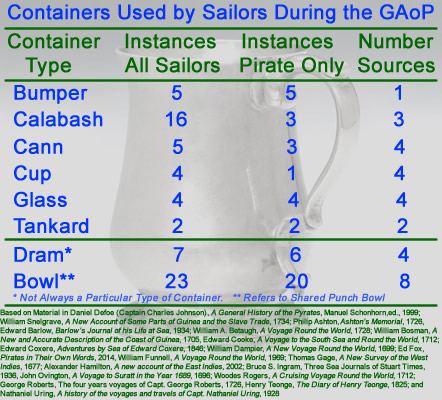
Types of Drnking Containers Used by Sailors and Pirates, With the number of Primary
Sources Mentioning Them Incldued for Reference.
there are still only a handful of references to drinking containers resulting in a fairly small data set. A such, this data could be easily skewed, particularly if a single source contains several references to one container. In fact, this is the case with bumpers, all of which come from George Roberts 1726 book The four years voyages of Capt. George Roberts. In addition, this book is considered to be fictional by several historians. As such, its information would best be confirmed by another independent period source, which isn't the case here.
Two of the most mentioned containers - drams and bowls - have other problems, which is why they are separated from the other containers here. As discussed, a dram doesn't necessarily refer to a specific container, although dram glasses existed. The bowl refers to a punch bowl, which was a community vessel and not useful for determining individual container use. Calabashes, although found in several sources and mentioned more often than any container other than the bowl, are considered primitive containers and, as noted above, are likely to be found in primitive settings. In addition, eleven of these instances come from Roberts' book and are concerned with his discussion of rather remote Cape Verde Islands.
It is tempting to draw conclusions about the frequency of use of containers when viewing the information here, but the limited number of instances found combined with some of the other factors indicate why this is not recommended. Instead, it is useful mainly for determining what kinds of containers were in use by sailors around this period.
1 Captain William Snelgrave, A New Account of Some Parts of Guinea and the Slave Trade, 1734, p. 96; 2 Daniel Defoe (Captain Charles Johnson), A General History of the Pyrates, Manuel Schonhorn, ed., 1999, p. 485; 3 Defoe (Captain Charles Johnson), p. 336; 4 Ed Fox, “67. Prices of Pirate Supplies: A List of the Prices that Capt. Jacobs sold Licquors and other Goods att, at St. Mary’s, 9 June, 1698…”, Pirates in Their Own Words, 2014, p. 362; 5 This is based on a search through Defoe/Johnson, William Snelgrave, Philip Ashton, Ashton's Memorial, 1726, Edward Barlow, Barlow's Journal of his Life at Sea in King's Ships, East and West Indiamen & Other Merchantman From 1659 to 1703, William A. Betaugh, A Voyage Round the World, 1728, William Bosman, A New and Accurate Description of the Coast of Guinea, 1705, Edward Cooke, A Voyage to the South Sea and Round the World in the Years 1708 to 1711, 1712, Edward Coxere, Adventures by Sea of Edward Coxere, 1846, William Dampier, A New Voyage Round the World, 1699, Ed Fox, Pirates in Their Own Words, 2014, William Funnell, A Voyage Round the World, 1969, Thomas Gage, A New Survey of the West Indies, 1677, Alexander Hamilton, British sea-captain Alexander Hamilton's A new account of the East Indies, 17th-18th century, 2002, Bruce S. Ingram, Three Sea Journals of Stuart Times, 1936, John Ovington, A Voyage to Suratt in the Year 1689, 1696, Woodes Rogers, A Cruising Voyage Round the World, 1712, George Roberts, The four years voyages of Capt. George Roberts, 1726, Henry Teonge, The Diary of Henry Teonge, Chaplain on Board H.M.'s Ships Assistance, Bristol, and Royal Oak, 1675-1679, 1825 and Nathaniel Uring, A history of the voyages and travels of Capt. Nathaniel Uring, 1928; 6 John Kersey, Dictionarium Anglo-Britannicum, 1708, not paginated; Noel Chomel, "Amber", Dictionaire Oeconomique, 1725, not paginated; 7 Beth Carver Wees, “American Silver Vessels for Wine, Beer, and Punch.” In Heilbrunn Timeline of Art History. New York: The Metropolitan Museum of Art, 2000; 8 Defoe (Captain Charles Johnson), p. 67, William Cockburn, The Diseases of Seafaring Peoples, 1696, p. 26 & 71, Ed Fox, “49. Mutiny on the Ship Adventure”, Pirates in Their Own Words, 2014, p. 255 & The Tryals of Captain John Rackam, and Other Pirates, 1721, p. 42; 9 Tryals of Captain John Rackam, p. 42; 10 Fox, “49. Mutiny on the Ship Adventure”, p. 255; 11,12 Defoe (Captain Charles Johnson), p. 67; 13 Tryals of Captain John Rackam, p. 42; 14 Cockburn, p. 71; 15 Ephraim Chambers, "Glasses", Cyclopaedia, Vol. 1, 1728, p. 158; 16 See Defoe (Captain Charles Johnson), p. 631, Charles Grey, Pirates of the Eastern Seas, 1618-1723, 1971, p. 36, Chaloner Ogle, Pyrates Lately taken by Captain OGLE, 1723, p. 54 & Ed Fox, "23. Bartholomew Roberts writes: Bartholomew Roberts to Lt. General Mathew, 27 September 1720.”, Pirates in Their Own Words, 2014, p. 109; 17 Defoe (Captain Charles Johnson), p. 631, Fox, p. 109, Chaloner Ogle, Pyrates Lately taken by Captain OGLE, 1723, p. 54; 18 Charles Grey, Pirates of the Eastern Seas, 1618-1723, 1971, p. 36; 19 David Wondrich, Punch, 2010, p. xxi; 20 Fox, 23. Bartholomew Roberts writes: Bartholomew Roberts to Lt. General Mathew, 27 September 1720.”, Pirates in Their Own Words, p. 109; 21 "An Account of All the Pyrates Lately taken by Captain OGLE", 1723, p. 54; 22 David Wondrich, Punch, 2010, p. 87; 23 Samuel Johnson, "Bumper", A Dictionary of the English Language, 1755, not paginated; 24 "Bumper glass", metmuseum.org, gathered 11/7/17; 25 Frances Phipps, "Antique Drinking Vessels of the Colonists", New York Times, Originally published 10-18-81, gathered from nytimes.com on 10/26/17; 26Roberts, p. 71; 27 Phipps, nytimes.com; 28,29 Roberts, p. 71; 30 Roberts, p. 82; 30 Chambers, "Cup", p. 356; 31 Chambers, "Calix", p. 144; 22 Rogers, p. 359; 34 Defoe (Captain Charles Johnson), p. 447, John Baltharpe, The straights voyage, or, St. Davids poem, 1671, p. 86, Rogers, 1712, p. 359 & Barlow, p. 270; 35 Defoe (Captain Charles Johnson), p. 447; 36 Baltharpe, p. 86; 37 Barlow, p. 270; 38 Rogers, 1712, p. 359; 39 William Hughes, The American Physitian, 1672, p. 63-4; 40,41,42 Hughes, p. 67; 43 Defoe (Captain Charles Johnson), p. 187 & Uring, p. 42; 44 Defoe (Captain Charles Johnson), p. 491 & Roberts, p. 150, 152, 154 & 260; 45 Roberts, p. 178, 179, 219, 311, 314, 326 & 327, 46 Defoe (Captain Charles Johnson), p. 504; 47 Uring, p. 145; 48 Pere Jean-Baptiste Labat, The Memoirs of Pére Labat 1693-1705, 1970, p. 54; 49 Kersey, "Dram", not paginated; 50 Edward Vernon, Quoted by L.G. Carr Laughton, “Document: Grog”, The Marinier’s Mirror, Vol. V., No. 3, September 1919, p. 89-90; 51 Regulations and Instructions relating to His Majesty’s Service at Sea, 1731, p. 61; 52 "Dram Glasses", 18cglass.co.uk, gathered 11/8/17; 53 Defoe (Captain Charles Johnson), p. 293, 348-9, Fox, “47. John Fillmore’s narrative”, Pirates in Their Own Words, p. 233, Fox, “49. Mutiny on the Ship Adventure”, Pirates in Their Own Words, p. 251 & 254-5, Barlow, p. 531, 54 Defoe (Captain Charles Johnson), p. 293; 55 Barlow, p. 53, Defoe (Captain Charles Johnson), p. 348-9 & Fox, “47. John Fillmore’s narrative”, Pirates in Their Own Words, p. 233; 56 Fox, “49. Mutiny on the Ship Adventure”, Pirates in Their Own Words, p. 251 & 254-5, 57 Defoe (Captain Charles Johnson), p. 293; 58 Barlow, p. 236; 59 Barlow, p. 52; 60 David Wondrich, Punch, 2010, p. 98; 61 Wondrich, p. 85; 62 Wondrich, p. 85-6; 63 Wondrich, p. 87; 64 Defoe (Captain Charles Johnson), pp. 150, 167, 172, 222, 334, 437, 478, 508, 525, 588, 591, 608 & 609, “The Tryals of Major Stede Bonnet”, 1719, p. 13, Charles Grey, Pirates of the Eastern Seas, 1618-1723, 1971, pp. 31, 35, 37 & 173, Ed Fox, “7. James Kelly on two decades at sea. (London, 1700)”, Pirates in Their Own Words, 2014, p. 47, The Tryals of Captain John Rackam, and Other Pirates, 1721, p. 47, Woodes Rogers, 1712, p. 390, William Cockburn, The Diseases of Seafaring Peoples, 1696, p. 71, Francis Rogers. from Bruce S. Ingram's book Three Sea Journals of Stuart Times, 1936, p. 213-4, 65 Wondrich, p. 128; 66,67 Defoe (Captain Charles Johnson), p. 334; 68 Captain Charles Johnson, The History of the Pirates, 1829, p. 112

